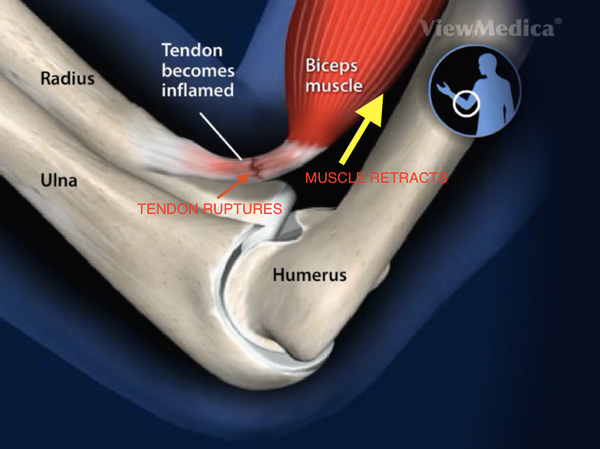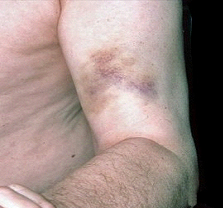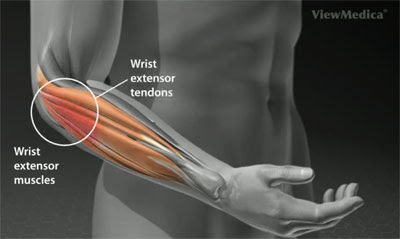Biceps Tendon Rupture
What is Distal Biceps Tendon Rupture?
Located at the front of the upper arm, the biceps brachii muscle is responsible for supination (external rotation) of the forearm and flexion of the arm at the elbow. Tendons are strong cord-like structures that connect muscles to bones to produce movement. The biceps has two tendons (long and short head) on the top that connect to the shoulder and one tendon at the base that attaches to the elbow. The long head articulates to the top of the shoulder at the glenoid socket and the short head connects to the shoulder blade at the coracoid process. The distal biceps tendon joins the lower aspect of the biceps muscle to a point on the radius bone called the radial tuberosity. Biceps tendon rupture (BTR) occurs when one of the tendons is torn (partially or completely) from the bone. Tears that occur in the shoulder are referred to as proximal tendon ruptures, while those occurring at the elbow are considered distal tendon ruptures.

What causes Distal Biceps Tendon Rupture?
Biceps tendon ruptures are usually the result of injury or overuse. The most common cause of rupture to the distal biceps tendon is when the bent arm is straightened forcibly in opposition to the biceps muscle contraction. Therefore, a hard fall onto an outstretched arm or lifting an object that is too heavy for the individual are frequent culprits for acute traumatic injury. Overuse ruptures occur from a chronic wearing down of the tendons over time, usually from some repetitive motion of the arm. Over time the tendons can fray and eventually tear.
Risk factors for BTR can include various elements. Biceps tendonitis can result from overuse and put more stress on the tendons increasing the likelihood of rupture. Nicotine use has been linked to reduced tendon nutrition, while medications such as corticosteroids have been associated with diminished strength in muscle and tendon fibers. Additionally BTR is more common in men 30 years and older.
What are the symptoms of Distal Biceps Tendon Rupture?

Upon rupture, clients report a sudden severe pain to the upper arm that dissipates over the course of a week or two. Occasionally an audible snap or popping sound can be heard. Weakness or the inability to bend the elbow or supinate the arm may occur along with marked ecchymosis (bruising) to the site of injury. When the distal tendon is completely ruptured, the biceps is no longer attached at the elbow and a bulge in the upper arm (Popeye Muscle) may appear as the biceps muscle recoils. Sometimes cramping in the biceps muscle is felt prior to rupture.
How is Distal Biceps Tendon Rupture diagnosed?
The doctor will take a detailed medical history to establish the cause of the rupture. A physical examination and diagnostic testing of the extremity will assess the severity of the injury to determine the best course of treatment. X-rays are used to rule-out bone fracture and other issues in the elbow and upper arm. MRI (magnetic resonance imaging) is used to visualize the soft tissues to determine if the rupture is partial or complete.
How is Distal Biceps Tendon Rupture treated?
Non-surgical
Course of treatment depends on numerous factors so it important to discuss options with your physician. In the case of a partial tear, initially ice packs may be applied (never directly to the skin) for up to 20 minutes several times a day to reduce swelling. NSAIDs (nonsteroidal anti-inflammatory medications) such as aspirin, naproxen and ibuprofen may be taken to ease pain and inflammation. The use of a sling may be recommended to ensure proper rest to the affected arm. Eventually, physical therapy may increase flexibility and range of motion (ROM). If there is a sizeable or complete tear usually surgery is recommended.
Surgical
Surgical repair ideally should take place within the first 3 weeks following the injury. After this time the biceps muscle and tendon begin to shorten, scar and heal. In the event of surgery the goal is to re-anchor the tendon to the bone. The surgeon will determine if the client is a candidate for a minimally invasive approach which hastens healing. The risk for complications is relatively low and usually temporary in nature.
After surgery the arm may be immobilized by either a splint, cast, and/or sling. Soon physical therapy will be introduced to restore range of motion, strength, and flexibility. The majority of patients will have a full return of function and appearance to the arm.

How can Dr. Knight help you with a Biceps Tendon Rupture?
As mentioned, Dr. Knight uses a novel method that avoids the necessity of metal anchors, which is, in the long term, much better for the healing process. It is important that you are able to return to your life and work just as before your injury, and Dr. Knight will make sure that that happens.
Dr. Knight is one of the premier hand surgeons in Dallas. We invite you to visit him at our Southlake office or Dallas office today.
Biceps Tendon Rupture Fact Sheet
| What things might lead to a rupture of the Biceps tendon? | The biceps tendon is almost always ruptured as the result of trauma, whether through aggressive oversuse or some external force. This can be the result of a fall or other accident. |
| What kinds of tests are useful in seeing if I have rutptured my biceps tendon? | Obviously, a physical examination of the area will give a good idea of the injury, but ultrasound and MRI can be used to look inside of the tissues to determine the extent of the injury. |
| What can I do to treat my ruptured Biceps tendon if I can't get to the doctor right away? | Icing, hot packs, anti-inflammatory medication and painkillers may help assauge symptoms of a tendon rupture, but will not serve to fully treat the condition. If yo ususpect that you have ruptured your biceps tendon, even partially, it is advisable to get to an emergency room as soon as possible, and then in to see a specialist for treatment. |
| What sorts of medications can be used to treat a ruptured Biceps tendon? | The abovementioned anti-inflammatory NSAID medications and painkillers may help reduce pain and inflammation related to the rupture, but will not act directly on the cause of the condition. |
| Are the effects of a ruptured biceps tendon permanent or will they disappear with time? | A partial or even full tear of the biceps tendon can easily be repaired either through conservative treatemnt or surgery, but if left untreated the rutptured tendon will permanently effect your mobility and your ability to use the affected limb. |
| What sorts of treatment does Dr. Knight recommend when dealing with a rupture of the Biceps tendon? | Partial tears require splinting and immobilization, while a full tear requires surgery, and both qill also need extensive physical therapy after to reach anything close to former activity. |
Frequently Asked Questions:
What are symptoms of a Biceps Tendon Rupture?
A ruptured biceps tendon, whether proximal or distal, is typified by a snapping sound that you can both hear and feel, intense pain, bruising, swelling and weakness. As a result of the rupture, there will be deformity in the affected are as the tendon bunches up on the side that is still connected to the bone. In short, it is impossible not to notice that your tendon is ruptured.
Can a Biceps Tendon Rupture heal without surgery?
Unlike extensor tendons and flexor tendons in the fingers, which may be repaired non-surgically with splinting, the biceps tendon is held in tension that makes it impossible for it to repair itself without the use of surgery. A partial tear may be treated conservatively without surgery, but that will entail a great deal of rest and inactivity in the arm so that the tendon can knit itself back together, followed by physical therapy to regain as much function as possible. If the tendon is completely torn, however, then surgery will undoubtedly be necessary to repair it, otherwise you will never regain full use of the arm, as the tendons and muscles in the arm are necessary in order to do basically anything with it.
How long does it take for a Biceps Tendon Rupture to heal?
After a surgical repair of the biceps tendon, the arm will be casted or splinted to keep you from moving too much and reinjuring the area, and a recovery period of three to six months should be expected.
Surgical Video
Note: The following video contains graphic images.
Distal Biceps Repair Animation Video
Distal Biceps Repair Testimonial
(817) 382-6789
Disclaimer
HandAndWristInstitute.com does not offer medical advice. The information presented here is offered for informational purposes only. Read Disclaimer

























